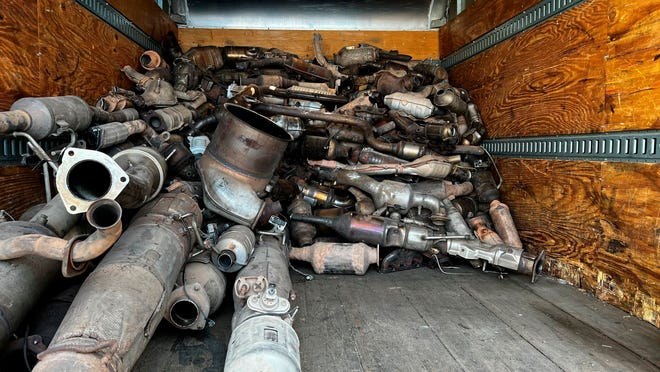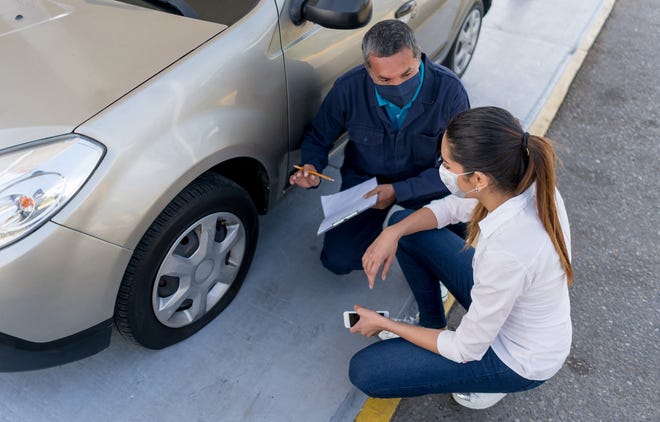Eggs and housing costs have been some of the inflationary buttons across the country over the past year or so. Car insurance can also be added to the list.
Drivers now pay an average of $2,014 a year, according to a Bankrate.com study that looked at comprehensive policies (which cover risks in addition to collisions such as vandalism and windshield damage). Based on what Americans earn, that equates to a 2.9 percent bite out of the median U.S. household income. Insurance premiums rose 13.7 percent nationally over the past year, the study found.
The rise in costs has been even more noticeable in certain areas, such as Orlando, where premiums rose an average of 22.6% over the past year, and metro Phoenix by 17.3%, according to the study According to the report, motorists in places like the Miami and Tampa areas now pay more than 5% of their income on average for insurance premiums, and only slightly better in Detroit at 4.8%.
Additional SNAP benefits to expire:Additional money for food supplies during the pandemic will run out.
Tax season guide for new parents:What you need to know about the child tax credit, EITC and more
Learn more: The best car insurance

Cheapest car insurance compared to income
By comparison, auto insurance is very affordable relative to income in and around Boston, Seattle, and Washington, DC, each around 1.3% to 1.5%, depending on the Bankrate.com study.
Just like you might buy more food or an apartment, this may be a good time to get a few more auto insurance quotes if you haven’t done so lately, especially if your driving patterns, credit scores, or other factors have changed. .
“There’s no downside to buying,” said Cate Deventer, auto insurance analyst at Bankrate.
Key benefits to finish; SNAP benefits in 2023 to end extra cash for food benefits provided during pandemic
Inflation drives up insurance costs
Inflation is the main culprit behind rising prices or premiums for auto coverage, with rising costs for mechanics, other types of labor, repair parts, and more. “Really, the numbers come down to inflation,” Deventer said.
He believes more premium increases could be on the way as insurers ask state insurance departments for higher rates to reflect price levels in 2022, when inflation was slightly higher than it is today.
Higher wages are being paid to mechanics, warehouse workers, drivers who deliver parts to repair shops, and people in many other roles. The increased labor costs are spread over “everything from creating and installing that bumper to the paint that goes on it,” said Jeff LaScala, an independent insurance agent and president of Coverage Pro in Sun City West, Arizona.
Who had the biggest pay rises? See if your job is listed.
![The National Highway Traffic Safety Administration estimates that 42,915 people died in motor vehicle crashes in 2021, a 10.5% increase from 2020 and the most since 2005. These victims include pedestrians and bicyclists. (They're not always fatal—these are the 20 deadliest car accidents in America.) The alarming increase in fatalities correlates with a […]](https://www.gannett-cdn.com/media/2022/08/25/USATODAY/usatsports/imageForEntry33-DAn.jpg?width=660&height=372&fit=crop&format=pjpg&auto=webp)
The increase in accident claims also affects car insurance premiums
Auto insurance premiums, of course, are also affected by the frequency and severity of claims. While the long-term trend has been favorable in many ways, collisions are on the rise again after a slowdown in the pandemic when many workers did not have to commute to work.
“After decades of decline, traffic deaths have increased in recent years due to riskier driving behaviors: speeding, driving under the influence, not wearing a seat belt, distracted driving,” says a commentary by the Insurance Information Institute.
In 2021, traffic deaths in the United States hit a 16-year high, with nearly 43,000 deaths, the group said, citing statistics from the National Highway Traffic Safety Administration.
With collisions on the rise, supplies still trying to catch up and more sophisticated and expensive parts going into each vehicle, repair costs are also rising, LaScala said. Even sensors in the windshield system may require microchips and calibration, he added.
Record Debt:US credit card debt hits record high as inflation leaves consumers financially stressed

Catalytic converter thefts are on the rise
And there are emerging repair issues, such as the trend toward more theft of catalytic converters, based on their precious metal content. With the right tools, two experienced thieves can steal a converter in less than two minutes, LaScala said. Thieves could get as little as $25 to $100 for selling a converter at a junkyard, while motorists could have to spend $1,100 or more to replace one, he added.
In this context, car insurers apparently misjudged the effects of the pandemic and its consequences. When accidents initially declined early in the pandemic, they returned $14 billion in refunds and account credits to customers, according to the Insurance Information Institute. But losses now exceed pre-pandemic levels and premiums will likely have to continue to rise “significantly” in the coming years, the organization predicts.
Catalytic converter thefts are on the rise:How to protect it from theft
Causing an accident could increase your insurance premium. So would adding a teenage driver to your policy. Even a noticeable drop in your credit score could be detrimental. Most states allow insurers to use credit scores to set premiums, since drivers with lower scores are statistically more likely to file claims, according to the Bankrate study. In general, premiums nationwide for people with poor credit scores were nearly double those for drivers with excellent credit, the report found.
California, Hawaii and Massachusetts are among the few states that restrict the use of credit to set auto premiums, according to Bankrate. Nevada has instituted a temporary ban on the practice.
How to lower the premium
But several factors can also lead to lower premiums, which can make comparison shopping worthwhile. The Insurance Information Institute suggests getting quotes from at least three insurers.
Also, you may be able to lower your premium by reducing coverage on older vehicles that may not be worth as much as you think. Other cost-saving suggestions include looking for a low-mileage discount if you don’t drive much, installing an anti-theft device, checking premium costs before buying a particular vehicle, and grouping your owners and policies car insurance with the same company.
And if you can afford to pay a little more for repairs outright, consider raising your deductible from, say, $200 to $500 or even $1,000. These increases could lead to a reduction in premiums of at least 15% and up to about 40% for collision and comprehensive policies, the institute said.
Insurers reward good drivers with lower premiums. If you’re willing to demonstrate your driving patterns, consider looking for discounts tied to multiple telematics devices, Deventer suggested.


